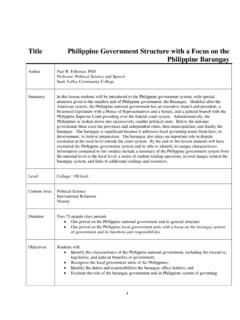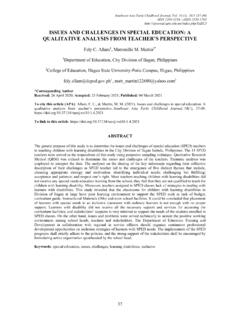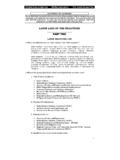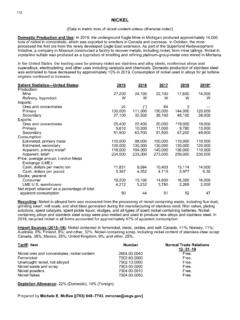Transcription of UNIVERSITY OF THE PHILIPPINES CUISIAOPEN UNIVERSITY ...
1 UNIVERSITY OF THE PHILIPPINES OPEN UNIVERSITY . Marie Camille Cuisia-Villanueva Jayrome N ez 25 July 2020. A Study on the Impact of Socioeconomic Status on Emergency Electronic Learning during the Coronavirus Lockdown Introduction This research paper tackles the relationship of socioeconomic status (SES) to students'. emergency electronic learning (e-Learning) during the Coronavirus (COVID-19) lockdown period in the PHILIPPINES . The study investigates the impact of accessibility to the students'. performance in distance learning. By looking at these variables, the researchers seek to answer the research question, what is the impact of the students' family socioeconomic status on their accessibility to emergency e-Learning'.
2 This mini-study will be viewed in the lens of human capital theory guided by Gary Becker (1964). As a consequence of COVID-19, schools worldwide resulted in shutting down, leaving over billion students out of their classrooms (Li and Lalani, 2020). As a rapid response, home learning was suggested to close the educational gap that might occur. Many countries across the globe shifted to e-Learning as a means to continue education during this pandemic. In the United Kingdom, education providers with the support of their Department of Education developed LendEd, a website where schools and teachers can search for resources for effective home learning ( , 2020). In France, the National Ministry of Education developed Ma classe la maison (My classroom at home) site that provides learning opportunities for everyone ( , 2020; The World Bank, 2020).
3 Japan, on the other hand, came up with a centralized website developed by the Ministry of Education, Culture, Sports, Science and Technology (MEXT) which includes strategies that schools in the country have been using for their e-Learning (The World Bank, 2020). Here in the PHILIPPINES , several institutions also resorted to online measures to keep classes running while the lockdown was implemented. Online platforms such as Google Classroom, Google Hangouts, Skype, Facebook groups, Messenger and Zoom were only some of the most used applications for conducting classes in the country (Abad, 2020). The Department of Education (DepEd) aims to continue distance learning in the next academic year; however, the marginalized will be at a disadvantage (Malindog-Uy, 2020).
4 Though the intention is good, many countries admit that they will face many struggles in implementing distance learning, and the most apparent among these issues will be access to technology. The problem lies in the larger social problem of digital inequality only the privileged can continue their education without being compromised (Aldama, 2020). As an example, there is a term coined homework gap in the United States which describes the barriers students face in their education when there is no access to a high-speed connection at 2 CUISIA-VILLANUEVA N EZ, 2020. their homes (Kelly, 2020). This has been a constant problem their country is trying to solve for many years even before COVID-19 and will be more prevalent during the pandemic.
5 Even in the United Kingdom, another first-world country, around million households do not have access to the internet and are relying on pay-as-you-go services (Kelly, 2020). This has also been the case even before COVID-19 struck their nation. If these well-developed countries are facing a digital divide, the least developed countries (LDCs) will become more susceptible to this issue . They will lag farthest behind in digital readiness and the education gap will keep expanding (UNCTAD, 2020). Just like in the PHILIPPINES , the availability of resources will have a significant impact on the students' distance learning journey and will widen the education gap. Some students from low-income households or remote areas do not have internet access and gadgets; and as per Albay Rep.
6 Joey Salceda shared, only 17% of Filipino students have internet access at home and only have mobile phones (Daguno-Bersamina & Relativo, 2020). Being in a third-world country, even middle-class citizens struggle with resources or may require extra support, depending on how near they are the poverty line (Albert, Santos, &. Vizmanos, ). Historically, new technologies have always benefited those with financial capital, and those who do not will always be left behind. Unfortunately, accessibility is highly related to SES, and this is where the digital divide begins. Children who come from low-SES households develop academic skills slower than those who are from higher SES families (Morgan, Farkas, Hillemeier, & Maczuga, 2009); primarily because poor households have less access to learning materials which promote a positive literacy environment (Bradley, Corwyn, McAdoo, &.)
7 Garc a Coll, 2001). For an instance, a study conducted among three hundred and ninety-nine (399) students in California State UNIVERSITY San Marcos concluded that those at an economic disadvantage are exposed to higher chances of experiencing difficulties accessing materials online (A over, Ng, & Pellicia, ). Another research done by Institute for Fiscal Studies (IFS) and Institute of Education (IoE) from England reported that children from poorer families spend less time learning at home during the lockdown due to the lack of study spaces and online resources (Andrew, Cattan, Costa Dias et al., 2020). Both studies show that there is a relationship between socio-economic status and accessibility; the lower a household's social status is, the higher the possibility their accessibility to education will be affected negatively.
8 Such mechanisms affect students' academic achievement based on human capital theory. The success of children coming from disadvantaged backgrounds are usually limited due to their family's status; they are confined by the restricted financial resources their families possess. The human capital theory explains that education is a significant human capital investment, whereas the difference in children's educational achievement is predominantly caused by the difference of family educational investment (Li & Qiu, 2018). When family resources are bounded, parents cannot invest competently in their children's education, which in turn, affects their children's academic achievement (Becker, 1964). Based on the studies discussed above, this mini-study aims to explore the relationship of SES in students' e-Learning experience during the COVID-19 lockdown.
9 The researchers will only focus on accessibility's impact on the students' e-Learning journeys. UNIVERSITY of the PHILIPPINES , Open UNIVERSITY 3 CUISIA-VILLANUEVA N EZ, 2020. Methodology The researchers conducted an online survey to collect the students' response. The respondents are senior high school (SHS) students from the Lyceum UNIVERSITY of the PHILIPPINES Laguna. These are fifteen (15) Grade 11 students coming from the Humanities and Social Sciences strand with ages ranging from sixteen (16) to eighteen (18) years old, both males and females, purposively selected. The whole section classified themselves coming from middle-class families. The school shifted to emergency e-Learning during the lockdown period and lasted for only three (3) weeks.
10 Due to the nature of the study, the researchers chose to do descriptive statistics to analyze the relationship between SES and e-Learning. Results and Discussion The study aimed to know if the SES of the respondents impacted their access to resources needed for their e-Learning sessions during the lockdown period. In return, if accessibility was affected, the researchers wanted to know if this influenced the students'. academic achievement. Ten (10) questions following a five-point Likert scale design that ranges from Strongly Agree, Agree, Neither Agree nor Disagree, Disagree and Strongly Disagree was conceptualized to measure the degree of students' responses. These points have assigned numerical values and will be discussed at a later point in this study.
















